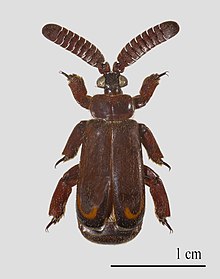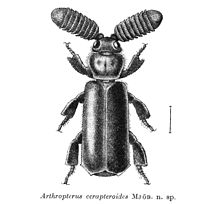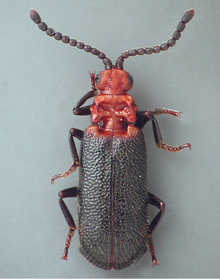| Ant nest beetles Temporal range: Cenomanian–Recent PreꞒ Ꞓ O S D C P T J K Pg N | |
|---|---|

| |
| Cerapterus pilipennis (Paussini : Cerapterina) | |
| Scientific classification | |
| Domain: | Eukaryota |
| Kingdom: | Animalia |
| Phylum: | Arthropoda |
| Class: | Insecta |
| Order: | Coleoptera |
| Suborder: | Adephaga |
| Family: | Carabidae |
| Subfamily: | Paussinae Latreille, 1807 |
| Tribes | |
|
Metriini LeConte, 1853 | |
Ant nest beetles (subfamily Paussinae) or paussines, some members of which are known also as flanged bombardier beetles, are a large subfamily within the ground beetles (Carabidae).The tribes Metriini, Ozaenini, Paussini and Protopaussini are included in the subfamily.
Rarely seen in the open, except at lights, most Paussinae are obligate or facultative myrmecophiles, living within the nests of ants, predatory on ant larvae and workers. Many have elaborate antennal structures and body parts flattened. Paussines are moderate sized (6–20 mm), characterised by glandular hairs that produce secretions attractive to ants and by the odd antennal structures of many species. Their pygidial glands can produce explosive secretions, with a spray of quinones that are directed forward by flanges at the posterior end of the elytra, giving them the other name of flanged bombardier beetles although they are not particularly close relatives of the typical bombardier beetles (Brachininae).
Biology
Very little is known about the immature stages of ant nest beetles. Most appear to live in ant nests in their early stages of life. Although many are facultative or obligate myrmecophiles, most do not appear like ants (i.e. myrmecomorphic) and unlike in the case of myrmecophilous larval Lycaenidae, there appears to be no benefit gained by the ants in this association. Many species follow the trails of worker ants of specific species. Glandular secretions on their antennae and body allow them to interact with ant workers. It is believed that the beetles use an acoustic mechanism to successfully imitate the sounds of an ant queen thus permitting them access to the nest without alarming the ants. Worker ants groom the beetles. Adult Paussus favieri have been observed to antennate and interact by stridulation with the queen of Pheidole pallidula in the brood chamber. The defensive bombardier behaviour is never used against ants. Unlike bombardier beetles in the family Brachininae, which have two glands opening close together on the abdomen, the glands are located close to the lateral margins and lie under a flange formed by the tip of the elytra. The flange is curved and the explosive hot spray of quinones is directed forward by Coandă effect. The flange is not present in members of the tribe Metriini but is replaced by similar internal structures. Males of some species are attracted to lights during some parts of the season and are thought to disperse from one ant nest to another. Males are thought to be short-lived. These beetles feed on ant eggs, larvae and adults by piercing their mandibles into the abdomen or other soft part and sucking the contents. Apart from chemical mimicry and communication with their hosts, they also make use of vibrations. Several stridulatory structures are found in these beetles including alary-elytral, abdomen-femur and thorax-femur combinations of surfaces. Larvae of only about 10 species have ever been examined. The first instar larvae of Paussus favieri has a terminal disc which is raised at times and bent back over the head. They also exhibit some behaviours and mouth part adaptations which may be involved in eliciting trophallaxis by the ant hosts but this has not been confirmed. They opportunistically feed on the haemolymph of ant larvae.
Systematics
The subfamily Paussinae contains 54 genera, with over 800 species divided into the following tribes and subtribes:
While some tribes like Metriini and Ozaenini appear quite similar to typical carabids, others have modified antennae and body shapes. The Protopaussini and Paussini are slender or compact in body shape with enlarged antennae in the Paussini.




These four tribes belong to the subfamily Paussinae:
- Metriini LeConte, 1853
- Subtribe †Kryzhanovskianina Deuve, 2019
- Ozaenini Hope, 1838
- Subtribe Microzaenina Deuve, 2019
- Subtribe Mystropomina G.Horn, 1881
- Subtribe Ozaenina Hope, 1838
- Subtribe Pseudozaenina Sloane, 1905
- Paussini Latreille, 1806
- Subtribe Carabidomemnina Wasmann, 1928
- Subtribe Cerapterina Billberg, 1820
- Subtribe Heteropaussina Janssens, 1950
- Subtribe Homopterina Wasmann, 1920
- Subtribe Paussina Latreille, 1806
- Subtribe Pentaplatarthrina Jeannel, 1946
- Subtribe †Arthropteritina Luna de Carvalho, 1961
- Subtribe †Eopaussina Luna de Carvalho, 1951
- Protopaussini Gestro, 1892
References
- Moore, W; Xiao-bin Song; Andrea Di Giulio (2011). "The larva of Eustra (Coleoptera, Paussinae, Ozaenini):a facultative associate of ants". ZooKeys (90): 63–82. doi:10.3897/zookeys.90.1136. PMC 3084492. PMID 21594107.
- Cammaerts, R; C Detrain; M-C Cammaerts. "Host trail following by the myrmecophilous beetle Edaphopaussus favieri (Fairmaire) (Carabidae, Paussinae)" (PDF).
{{cite journal}}: Cite journal requires|journal=(help) - Andrea Di Giulio; Emanuela Maurizi; Francesca Barbero; Marco Sala; Simone Fattorini; Emilio Balletto; Simona Bonelli (2015). "The Pied Piper: A Parasitic Beetle's Melodies Modulate Ant Behaviours". PLOS ONE. 10 (7): e0130541. doi:10.1371/journal.pone.0130541. PMC 4496082. PMID 26154266.
- Robertson, James A.; Moore, Wendy (2017). "Phylogeny of P aussus L . ( C arabidae: P aussinae): unravelling morphological convergence associated with myrmecophilous life histories". Systematic Entomology. 42 (1): 134–170. doi:10.1111/syen.12205. ISSN 0307-6970. S2CID 89078626.
- Eisner, Thomas; Aneshansley, Daniel J. (1982). "Spray Aiming in Bombardier Beetles: Jet Deflection by the Coanda Effect". Science. 215 (4528): 83–85. doi:10.1126/science.215.4528.83. ISSN 0036-8075. PMID 17790472. S2CID 32476957.
- Muzzi, Maurizio; Moore, Wendy; Di Giulio, Andrea (2019). "Morpho-functional analysis of the explosive defensive system of basal bombardier beetles (Carabidae: Paussinae: Metriini)". Micron. 119: 24–38. doi:10.1016/j.micron.2019.01.003. PMID 30660089. S2CID 58617706.
- Geiselhardt, Stefanie F.; Klaus Peschke; Peter Nagel (2007). "A review of myrmecophily in ant nest beetles (Coleoptera: Carabidae: Paussinae): linking early observations with recent findings". Naturwissenschaften. 94 (11): 871–894. doi:10.1007/s00114-007-0271-x. PMID 17563864. S2CID 945199.
- Di Giulio, Andrea; Maurizi, Emanuela; Hlaváč, Peter; Moore, Wendy (2011). "The long-awaited first instar larva of Paussus favieri (Coleoptera: Carabidae: Paussini)". European Journal of Entomology. 108 (1): 127–138. doi:10.14411/eje.2011.016.
- "Paussinae Latreille, 1806". Catalogue of Life. Retrieved 2023-03-13.
| Taxon identifiers | |
|---|---|
| Paussinae | |